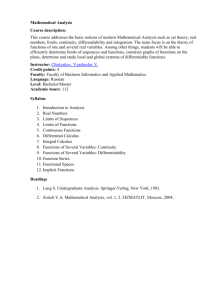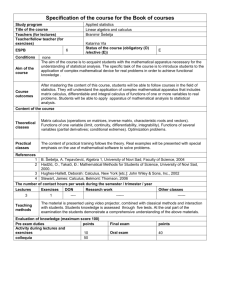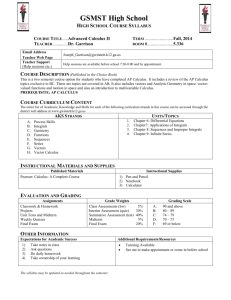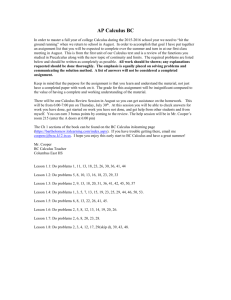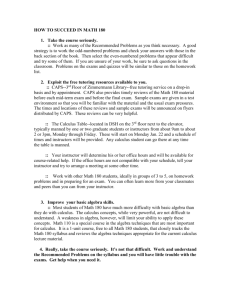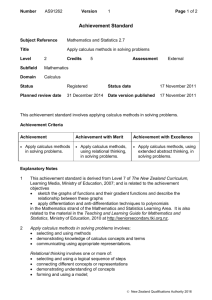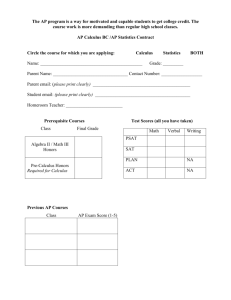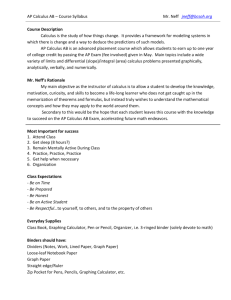Applied Calculus M162.00 – 74672 – Fall 2014
advertisement
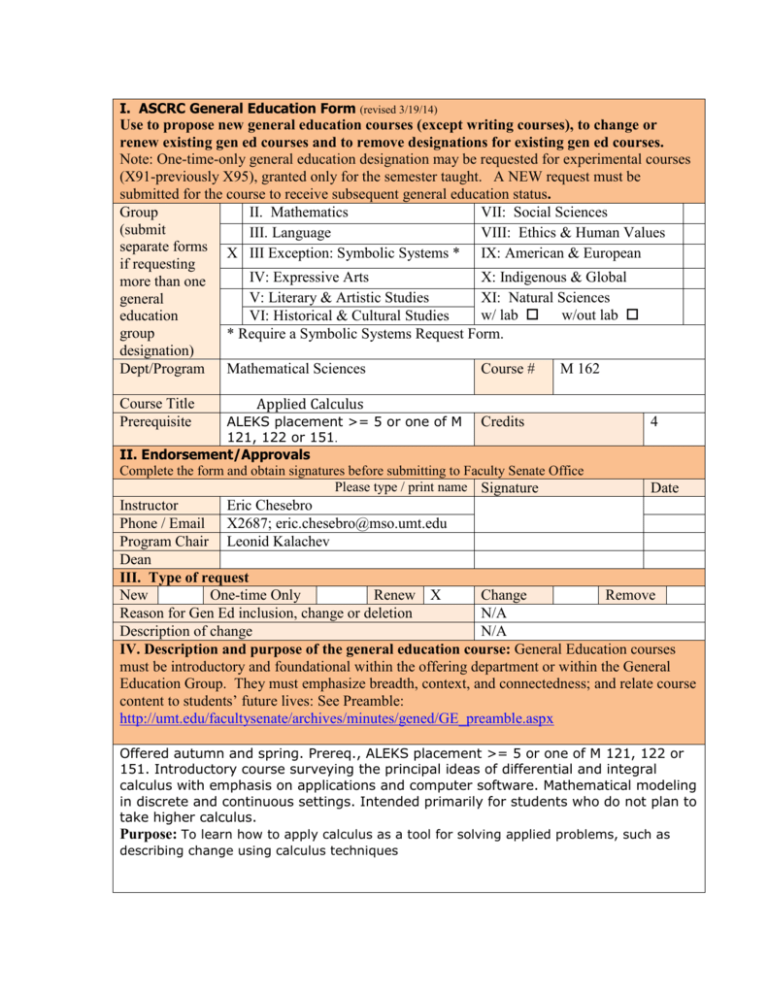
I. ASCRC General Education Form (revised 3/19/14) Use to propose new general education courses (except writing courses), to change or renew existing gen ed courses and to remove designations for existing gen ed courses. Note: One-time-only general education designation may be requested for experimental courses (X91-previously X95), granted only for the semester taught. A NEW request must be submitted for the course to receive subsequent general education status. Group II. Mathematics VII: Social Sciences (submit III. Language VIII: Ethics & Human Values separate forms X III Exception: Symbolic Systems * IX: American & European if requesting IV: Expressive Arts X: Indigenous & Global more than one V: Literary & Artistic Studies XI: Natural Sciences general w/ lab w/out lab education VI: Historical & Cultural Studies group * Require a Symbolic Systems Request Form. designation) Dept/Program Mathematical Sciences Course # M 162 Course Title Prerequisite Applied Calculus ALEKS placement >= 5 or one of M Credits 121, 122 or 151. II. Endorsement/Approvals Complete the form and obtain signatures before submitting to Faculty Senate Office Please type / print name Signature 4 Date Instructor Eric Chesebro Phone / Email X2687; eric.chesebro@mso.umt.edu Program Chair Leonid Kalachev Dean III. Type of request New One-time Only Renew X Change Remove Reason for Gen Ed inclusion, change or deletion N/A Description of change N/A IV. Description and purpose of the general education course: General Education courses must be introductory and foundational within the offering department or within the General Education Group. They must emphasize breadth, context, and connectedness; and relate course content to students’ future lives: See Preamble: http://umt.edu/facultysenate/archives/minutes/gened/GE_preamble.aspx Offered autumn and spring. Prereq., ALEKS placement >= 5 or one of M 121, 122 or 151. Introductory course surveying the principal ideas of differential and integral calculus with emphasis on applications and computer software. Mathematical modeling in discrete and continuous settings. Intended primarily for students who do not plan to take higher calculus. Purpose: To learn how to apply calculus as a tool for solving applied problems, such as describing change using calculus techniques V. Criteria: Briefly explain how this course meets the criteria for the group. See: http://umt.edu/facultysenate/documents/forms/GE_Criteria5-1-08.aspx 1. rigorously present a mapping between a real- Calculus presents the tools for analyzing world system and a human abstraction of the mathematical models of real-world system. phenomena involving change. 2. applies analysis, reasoning and creative This course utilizes tools within the language thinking in the understanding and manipulation of mathematics (like differentiation and of symbolic codes. integration) to analyze models involving change and to use them to make predictions. 3. utilizes alternative methods of This course emphasizes the connection communication, perception, and expression in between graphical and analytical order to encourage rigorous thinking. representation of functions, derivatives and integrals. VI. Student Learning Goals: Briefly explain how this course will meet the applicable learning goals. See: http://umt.edu/facultysenate/documents/forms/GE_Criteria5-1-08.aspx 1. demonstrate an understanding of the symbols This course emphasizes the translation of and the transformations of the system. real world problems into the language of mathematics. See esp. Learning Outcome 1 on the syllabus below. 2. relay and interpret information in terms of the A major goal for this course is to convey the given symbolic system. “meaning” of the derivative and the integral in terms of real world problems. This should enable students to use calculus as a tool for solving applied problems. See esp. Learning Outcomes 1, 2 and 3 on the syllabus below. 3. apply creative thinking using the symbolic Creative and flexible thinking are crucial to system in order to solve problems and solve applied problems with calculus and to communicate ideas. model real world phenomena with differential equations. We try to emphasize problem solving strategies, rather than recipe to encourage creative thinking, conceptual understanding, and the use of mathematical symbols and concepts as a flexible problem solving tool. See esp. Learning Outcomes 1 and 4 on the syllabus below. VII. Assessment: How are the learning goals above measured? Please list at least one assignment, activity or test question for each goal. 1. Learning outcomes are assessed by embedded questions on the final exam. Specific questions are written to assess different learning outcomes and the assessment report is written based on student performance on these questions. 2. See 1. 3. See 1. VIII. Justification: Normally, general education courses will not carry pre-requisites, will carry at least 3 credits, and will be numbered at the 100-200 level. If the course has more than one pre-requisite, carries fewer than three credits, or is upper division (numbered above the 200 level), provide rationale for exception(s). N/A IX. Syllabus: Paste syllabus below or attach and send digital copy with form. The syllabus should clearly describe learning outcomes related to the above criteria and learning goals. Applied Calculus M162.00 – 74672 – Fall 2014 MWF in NULH 101 12:10P-1P Instructor information Instructor: Eric Chesebro Office: 214 Mathematical Sciences Email: eric.chesebro@mso.umt.edu Phone: x2687 Office hours: TBA Teaching Assistants Dennis Moritz Office: Corbin 354 Email: dennis.moritz@umontana.edu Phone: x4483 Office hours: TBA Trevor Shumaker Office: Corbin 354 Email: trevor.shumaker@umontana.edu Phone: x4483 Office hours: TBA Course overview: Calculus is the mathematics of changing quantities. It provides a sophisticated tool for understanding our changing world. With an emphasis on applications, this course studies the relationship between a function and its rate of change and introduces derivative and integral calculus. Learning Goals: This class will emphasize the following skills: 1. Problem solving, especially working on problems which you have not already been shown how to solve. 2. Slow and clear rational thinking. 3. Effective mathematical writing, both for communication and as a litmus test for your own understanding. Learning Outcomes: Upon completion of this course, a student will be able to: 1. Apply calculus as a tool for solving applied problems, such as describing change using calculus techniques; 2. Use the basic techniques of differentiation and demonstrate understanding of the meaning of derivative; 3. Use the basic techniques of integration and demonstrate understanding of the meaning of indefinite and definite integral; 4. Apply basic elementary modeling in terms of differential and/or difference equations; 5. Demonstrate familiarity with some mathematical software as a tool for applying calculus. Textbook: Calculus with Applications, Hughes-Hallett et. al. (There is a custom University of Montana textbook available at the UM bookstore.) Tests: We will have three 50 minute midterm exams during the semester. They will be on Friday Sept. 26, Friday Oct. 24, and Friday Nov. 21. You will also have a 2 hour final exam which will be given according to the Registrar's schedule. It is your responsibility to take these exams at the scheduled time. All of these tests are closed book exams, however you will be permitted to bring a pre-prepared 4” x 6” note card with handwritten notes on both sides. Homework: Weekly homework assignments will be posted on Moodle. Homework will be collected at the beginning of class at your section meeting. Late homeworks will not be accepted unless you have a convincing reason for its lateness. You are allowed to work together on homework, but keep in mind that on the exams you will be alone. Be sure that, by the time you hand in your assignment, you are able to do the problems without help. Your finished assignments should always be written neatly and in your own words. In each assignment I will assign both PRACTICE and WRITING problems. The homework grader will look to see if you’ve done the PRACTICE problems, but will not mark them as correct or incorrect. If you do all the PRACTICE problems you will receive full credit on them regardless of whether or not you do them correctly. The grader will choose problems from the WRITING problems to grade carefully. The grader will assess the completeness and clarity of the justification for your answer as well as its correctness. The goal here is to be writing excellent solutions to these problems. You should use this website about Mathematical Writing from the University of Michigan as a guide for what is expected. As outlined on the U. Michigan site, for a WRITING problem to receive full credit, it must 1. 2. 3. Begin with a restatement of the question as you understand it Include computations with explanations End with a clear, concise conclusion The time you spend struggling with homework problems is most likely the most important time you will spend on this course. Please take it seriously and be generous with the time and energy that you put into it. Grading: The point distribution for the final course grades will be: 20% homework, 55% midterm exams, and 25% final exam. Your lowest midterm exam score will be weighted to be half the value of your other two scores. Letter grades will be assigned as follows: F 0-54 D5557 D 5861 D+ 6264 C6569 C 7074 C+ 7579 B8082 B 8386 B+ 8789 A9092 A 93100 Course guidelines and policies: Politeness You are expected to be polite to me and your classmates. This includes coming to class on time, acting interested in engaged, and not using electronic devices and computers for social reasons during class. Calculators Electronic devices (eg. Calculators) will NOT be permitted or necessary for any tests. You should feel free to use them on your homework. University Dates and Deadlines You should be aware of the Important dates and deadlines for Fall 2014 posted by the Registrar’s office. Academic Honesty I take academic honesty very seriously and I will act on any transgressions that I notice. Misconduct is subject to an academic penalty in this course and/or a disciplinary sanction by the university. We all know that a record of academic misconduct is a very bad thing to have documented in your academic history. Student Conduct Code All students should be familiar with the Student Conduct Code. Disability modifications The University of Montana assures equal access to instruction through collaboration between students with disabilities, instructors, and Disability Services for Students. If you think you may have a disability adversely affecting your academic performance, and you have not already registered with Disability Services, please contact Disability Services in Lommasson Center 154 or call 406.243.2243. I will work with you and Disability Services to provide an appropriate modification. Please note: Approved general education changes will take effect next fall. General education instructors will be expected to provide sample assessment items and corresponding responses to the Assessment Advisory Committee.

